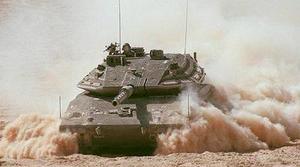In the trenchesThe (re-)emergence of the Main Battle Tank
Many eulogized the Main Battle Tank as a relic of the past; armies no longer fight other countries’ armies, but rather non-state actors — often in urban setting; moreover, these sub-national organizations are equipped with sophisticated anti-tank weaponry which makes the employment of heavy armor costly (as Israel learnt in its war with Hezbollah in the summer of 2006); this is changing, though, as armies retrofit their tanks to make them relevant for asymmetrical warfare

The Merkava MK4 will get an urban makeover // Source: hashmonean.com
It used to be the conventional wisdom that the age of the Main Battle Tank has come to an end, for two reasons. The first is that war between large armies – wars like the Second World War, the 1967 and 1973 wars in the Middle East – is a thing of the past, replaced by asymmetric wars between states and non-state actors (the United States versus al Qaeda and the Taliban; Israel versus Hamas and Hezbollah; Russia versus the Chechen rebels, Sri Lanka against the Tamil Tigers, etc.). The second reason is that these non-state actors, especially in the Middle East, have received lethal anti-tank weapons from Iran and Syria, making the use of tanks against them costly (as was the case in the Israel-Hezbollah war of summer 2006). Hezbollah fighters used Russian-made sophisticated anti-tank Kornet missiles with lethal effect.
It appears that the MBT has a second life after all. Aviation Week reports that Israel has found a way to turn its leading MBT, the Merkava MK4, into an important element in its asymmetrical war against Hezbollah and Hamas. Israel, but also European manufacturers such as Krauss-Maffei Wegman (KMW) and Rheinmetall are working on improving design, crew protection, and lethality to make the tank relevant again.
Among the changes and improvements Israel has made to the Merkava:
- Ammunition: a subsidiary of Israel Aerospace Industries (IAI) developed Lahat, a missile fired through the barrel of a tank, using semi-active laser homing.
- Munitions: Israel Military Industries’ (IMI) APAM high-explosive, multipurpose M339 tank round offers a single munition for different targets, thus obviating the need for different rounds
- Survivability: AW notes that Merkava’s modular, open-platform approach design turned the MBT “into a versatile platform optimized for a changing battlefield. The Merkava shifts rapidly from low-intensity warfare to high-intensity counter-armor operations.”
- Protective envelope. One of the more intriguing new features of the Merkava is the Trophy APS protective system. In March, for example, an RPG was launched from Gaza against the a merkava on patrol. The Elta System /EL/M 2133 WindGuard alerted the crew, locked in on the projectile, classified it as a threat, and when it came within range, engaged it and destroyed it.
The Merkava is already a flexible and versatile fighting machine. AW notes that in order to make it even more so, the Israeli military is looking at additional modifications, including “developments in ammunition, miniaturization of components, elevated observation needs in urban combat, advanced communications, APS radar, new camouflage materials, stealth technologies and enhanced life-support systems for crews.”
